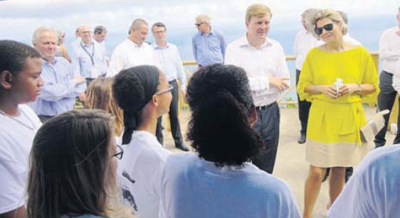The Daily Herald writes that King Willem-Alexander and Queen Máxima’s official stopover on their opening of the Spring Bay Heritage Trail and observation deck this Thursday was received as the greatest honour and recognition that their majesties could have given to the archaeological programme established by local youth and their mentors. The Saba Archaeological Centre Sabarc was started in 2011 by Dr. Jay B. Haviser of St. Maarten Archaeological Centre Simarc and Leiden University PhD. Candidate Ryan Espersen who resided on Saba and led interested youth on weekly fieldwork research trips. Espersen said “it is a unique honour to have efforts like these recognized by the Royals especially since, when it comes to archaeology, I don’t know of many programmes that enjoy this kind of recognition. It is a true honour, we don’t take these things for granted and we realize the depth and meaning of their gesture.”
In May 2012 Sabarc Foundation was established formalizing and extending the reach of the programme, leading to youth exchange visits among Saba, St. Maarten and Bonaire peers. On Saba, the youth’s interest in discovering their ancestral history really took off when Espersen temporarily became a local high-school teacher in order to fund his research residency on Saba. Ten per cent of the Saba Comprehensive School’s youth are consistently active in the programme which stimulates interest in scientific research processes, including providing lab research.
Once the King and Queen arrived, they were invited to the observation deck just upgraded by the Public Works Department on top of an old, large grey water cistern. The preparations involved clearing some of the vegetation to allow the spectacular view and placing safety railings. Even without the archaeological sightings below, the observation deck is a tourist asset affording views of the airport, Flat Point, Spring Bay and Old Booby Hill. It will likely become an attraction for those tourists that cannot venture on the “Heritage Trail,” said Esperson. Following protocol, the participating youth were linedup in specially issued Sabarc Foundation T-shirts, holding a placard with a photo-collage of all the field work they were involved in. The Royal Couple was invited by Dr. Haviser to inspect the archaeological digs with binoculars. Sensing the youth’s emotions their majesties softened the protocol making everyone feel at ease. Espersen said “it was a little disarming to see his majesty so relaxed. I expected them to feel more distant but both the King and the Queen were very, very personable.” He explained what discoveries were made at each of the archaeological sites and the implications of findings.
At Spring Bay Flat, the Royals could see the remains of the recently unearthed eighteenth century sugar plantation that operated sometime between 1720 and 1805. The standing walls of that site were used in building the Catholic Church in Windwardside in the 1850s, but the cisterns and foundations remain a visible complex. At sea-level on Spring Bay another archaeological site documented an earlier 17 century plantation and at the end of the trail, on a hill there are likely ruins of the masters’ house, overseeing both plantation operations and boiling house. The house would have rested atop a pyramidlike staircase which Espersen hopes the island would restore. The archaeological digs gave insight into the enslaved labour as well as floorings of African-like huts, an architectural style that appears to be unique to Saba, unknown of in the Caribbean region.
Her Majesty Queen Máxima was quite interested to hear from the participating students what they thought of the programme, of participating in the discovery of their own history and what their parents thought of it. The students spoke openly about their parent’s support and how at times they would share their findings with them. Student Donald Hassell presented the Queen with three necklaces of purple glass beads for the Royal Couple’s daughters. These are bead replicas created by expat resident glasswork artist JoBean Chambers based on a purple glass bead discovered on the archaeological site. Esperson identified the bead as typical for 18th century French slavetrade, with a similar bead exposed in a Nantes Museum. Their Majesties were also interested in Ryan Espersen’s academic findings as a Leiden University PhD Candidate and the funding provided by a European union-sponsored Marie Curie programme for the investigation of the Transatlantic Slave Trade. Espersen believes that the Royal interest and the support of the government will lead to a Saba Heritage Centre, an institution that could accommodate the return of various artefacts currently stored in European Netherlands. Its construction next to the old library building is to commence next year. Sabarc even plans to take the youths to an international archaeological conference in 2015 to be present on the results of their findings.

 Archive of posts from Saba-News.com Archive Saba News
Archive of posts from Saba-News.com Archive Saba News